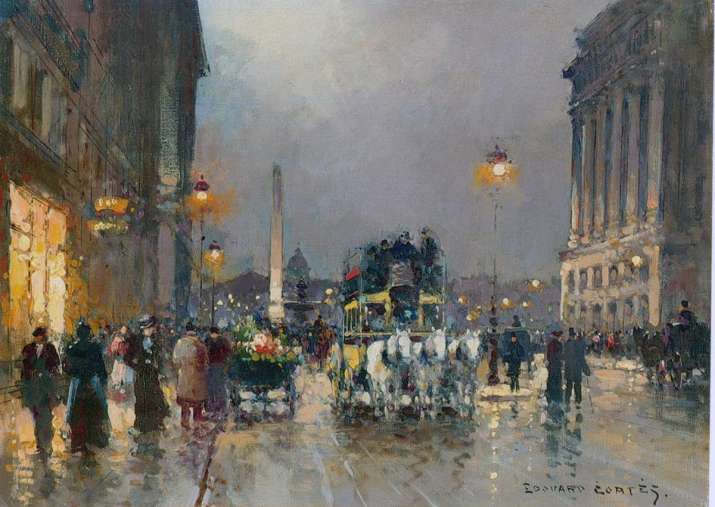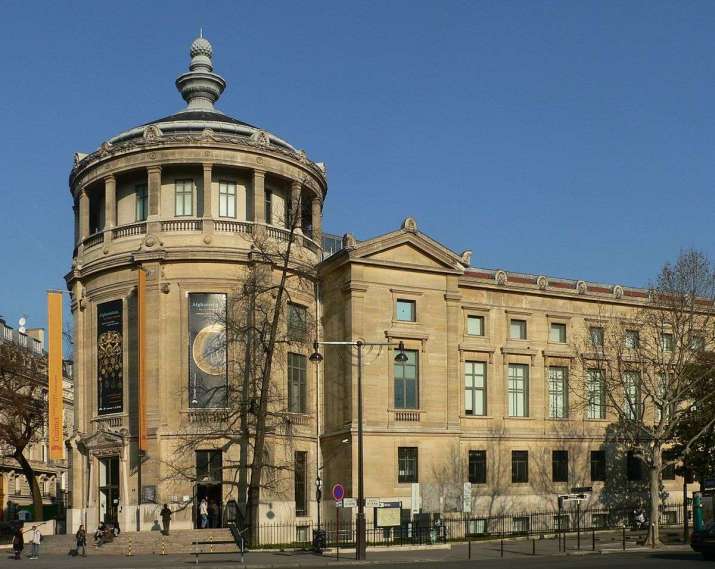
In 1912, when she met with the 13th Dalai Lama in Kalimpong, the renowned French explorer Alexandra David-Neel introduced herself as “the first Buddhist in Paris.” She insisted that nobody in France before her had ever practiced meditation nor even adopted Buddhist principles in their daily lives. Obviously, Buddhism had been studied in texts by several Sorbonne professors and their students. France had even produced many great linguists, such as Eugène Burnouf and Sylvain Lévi, but what had they done, really? Dissect Sanskrit roots, said the former opera singer, who ended her career to become a famous writer specialized in all things Asian. She, on the other hand, was a practicing Buddhist and, as such, she was pleased to meet with the Dalai Lama on an (almost) equal footing.
What Alexandra David-Neel actually thought of the Dalai Lama and of his religion is a more complicated issue. Here, I would like to take her claims as an opportunity to think about Buddhism in France at the end of the 19th century. Is it true that she was “the first Buddhist in Paris?” Of course not, but that is totally unimportant. What is more interesting is the way the French people of her time understood the notion of “being a Buddhist.” The Sorbonne scholars, who indeed spent their time studying and translating Sanskrit texts rather than travelling to Asia, did not exactly think of themselves as Buddhists. While they often privately or publicly confessed their admiration for Buddhism, they still were not the “scholar-practitioners” that we know today. They were not even “scholar-believers.” They were just “scholars” with a passion for their topic of research.
This passion, however, was not absolutely pure. Indeed, it was not (only) intellectual curiosity that spurred them to study Buddhism, but a spiritual quest. The latter had nothing to do with the research of individual enlightenment through the knowledge of the scriptures and the practice of meditation under the guidance of an authorized master. Very few—if any—French people of the time ever considered practicing Buddhism the Asian way. What many intellectuals had in mind regarding Buddhism, instead, was the enlightenment of society. Indeed, Western admirers of Buddhism, and proponents of a pure “Aryan civilization” that was once purely Indo-European, took the discovery of the Buddhist teachings as a chance to reform a Europe they perceived as “decadent” or “degenerate.”
This “degeneration,” some thought, had to do with Europe’s assimilation of Judeo-Christian ideology. Christian dogma and morality were no longer beneficial and had led to the ossification of European strength. “Aryan thought,” or at least the lens through which many thinkers, including Buddhist scholars, projected on to Indian thought, was about muscular facts, science, and atheism. The Buddha, who was then described as a social reformist with no religious or metaphysical inclination, appeared as the perfect secular saviour.
It is in this context of the French intellectuals’ obsession with regeneration that the interest for Buddhism in fin-de-siècle (end of century) Paris should be understood. Indeed, Buddhism was so trendy in Paris in the 1890s that many articles appeared in the French and international press to investigate this phenomenon. It was called “Neo-Buddhism” or “Parisian Buddhism,” and appeared in various areas of Parisian cultural life: the museums (especially in the Guimet Museum), the arts like paintings, literary and theatrical works, and the decorative arts (given the vogue that was “Japonisme,”), in academia, in spiritual movements like Theosophy, in philosophy (with connections made between Buddhism and philosophical pessimism), and in politics: Buddhism was conceived by some activists as an antique form of socialism or anarchism.
To call oneself a Buddhist and publicly be considered as one, it was not enough to participate in a theatrical “Buddhist” play or in a public ritual given by visiting Japanese priests at the Guimet Museum, or to read Burnouf, possess a small Buddha statue, or write a Buddhist-inspired anarchist manifesto. There were a few provocative statements, the best known probably being Georges Clemenceau, the anticlerical prime minister and former minister of war, who declared to a journalist that there was no issue with attending the “Buddhist mass” at the Guimet Museum, since “[he was] a Buddhist”. But nobody was “a Buddhist” the way we understand it today.
However, there was a man in Paris who dared to call himself a Buddhist and even built his own “Buddhist” school. The young Alexandra David, as a matter of fact, knew him very well. This man has largely been forgotten, although he probably played a great part in the introduction and transformation of Buddhism in France. Léon de Rosny (1837–1914) was an ethnologist, linguist, and philosopher who became a specialist on Japan. Among the dozens books he published, a few deal with Buddhism. His most influential book was entitled Eclectic Buddhism, written in 1894. Because this book was so popular he created a small school, “the Eclectic School”, which directly challenged official scholarly discourse on Buddhism in Paris.

Strangely enough for an ethnologist, de Rosny thought that history and context did not matter. Only “ideas” counted. One should not care, he said, if certain ideas came from Jesus Christ, the Buddha, or Voltaire. What counts is the intrinsic value of the idea. In his philosophical system, the most important ideas are “universal love” and “moral accomplishment.” They can be found in many traditions, and should be combined together to get to the most universal human truths—hence the term “eclectic.” Neither Asian teachers nor Sanskrit scholars are needed to understand “true Buddhism.” What is needed is philosophers like himself.
In the introduction to his book Eclectic Buddhism, he describes it as “the substance that can be derived from Buddhism, as it results from the work of ages and from the progress that was made necessary by critical thought.” (de Rosny 1894, viii) This is a Buddhism read in the light of the ideology of progress, for de Rosny was first and foremost a disciple of Auguste Comte and dearly believed in “Progress.” De Rosny has extracted this “substance” from “the best doctrines of old Asia,” in order to “take advantage of them for the study of the problem of Life and Destiny,” to “learn what Buddhism could offer us, not only to examine, under a favourable light, the obscure question of our origins and ends, but also to determine the moral and intellectual law of our conduct on this earth.” (de Rosny 1894, vi)
Eclectic Buddhism seems to be a hybrid doctrine that mixes Positivism, Buddhism, and Christianity. It is quite close to the definition Henry Steel Olcott gave of Buddhism a decade before in his Buddhist Catechism (1881): its essence is “self-culture and universal love,” it imposes no irrational beliefs, and is compatible with the latest state of scientific knowledge. De Rosny actually mentions Olcott’s Buddhist Catechism several times in his footnotes. He might have gotten many of his ideas from him. However, Eclectic Buddhism is more philosophical and abstract in its formulation. It also, surprisingly, rejects some of the new dogmas imposed on Buddhism in the second half of the 19th century.
Notably, de Rosny did not consider the Buddha to be an atheist; he simply did not bother to define what God really is. According to de Rosny, the Buddha did believe in God, but not in a God interested in human history. His reasoning was an implicit syllogism: “The most gigantic hypothesis ever formulated by the human mind is most probably the idea of God.” (de Rosny 1894, ix) Shakyamuni was one of the most sophisticated thinkers in history; therefore, he could not have concluded that God does not exist. Another original feature is the value de Rosny attributed to suffering. Whereas most Buddhist modernists claim that the Buddha’s most interesting contribution was his revelation of the “Four Noble Truths” and his condemnation of suffering, de Rosny believed that those truths were only a tiny and superficial part of his teachings.
According to the same kind of syllogism, the Buddha could not have condemned suffering since suffering is “the spur of moral rectification” and “the work of God.” (de Rosny 1894, xxx) His real teachings, de Rosny claimed, consisted in other truths. People can triumph over every obstacle through meditative research coupled with moral rectification. The most important practice is to love all creatures, the second is to seek Knowledge, and the ultimate goal of humanity is to reach perfection, which is essentially a kind of moral perfection. As some observers of the time indicate, de Rosny’s doctrine attracted disciples but was not well received by other scholars, who defended a more academic approach to Buddhism based on philology and history.
De Rosny and his Eclectic Buddhism disappeared from public and academic attention, although he was instrumental in the multifaceted redefinition of “Buddhism” in France and in Europe at the turn of the 20th century. He exemplifies a tendency that was then prevalent: Buddhism as a twin brother of Christianity, with the same belief in God (but a Gnostic or Hindu deity than a theistic one), the same emphasis on suffering as a spiritual force (rather than an obstacle to happiness that should be eradicated), and the predominance of love and compassion over the intellect. This doctrine gives the impression that its pioneer was still very much a Christian, but a dissatisfied one, who looked for complements and corrections elsewhere. It is not a surprise that Alexandra David-Neel did not count him as a real “Buddhist” (although she was partly educated in his school), since for her Buddhism was the exact opposite of Christianity, which she described as the overemotional and irrational beliefs of “neurotic Galilean fishermen . . .”
Reference
de Rosny, Léon. 1894. Le bouddhisme éclectique, Paris, Ernest Leroux.











